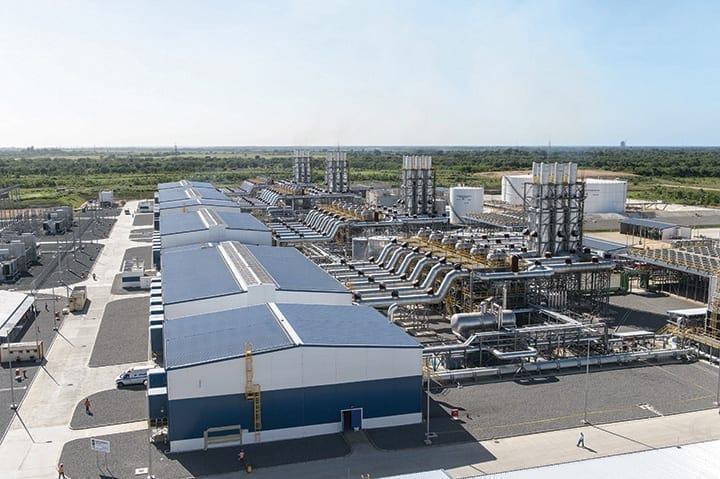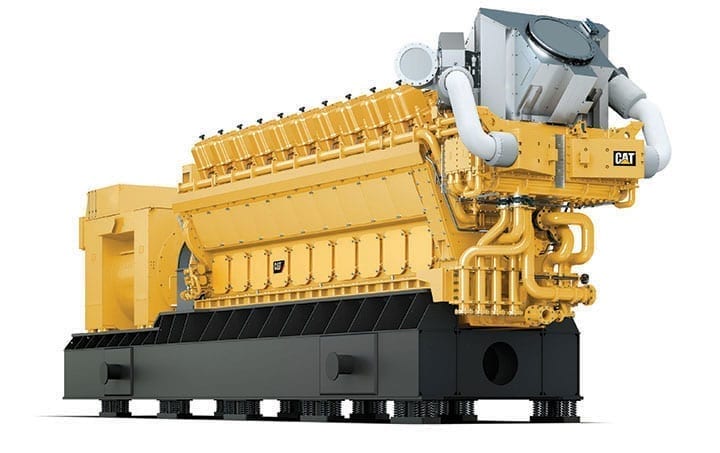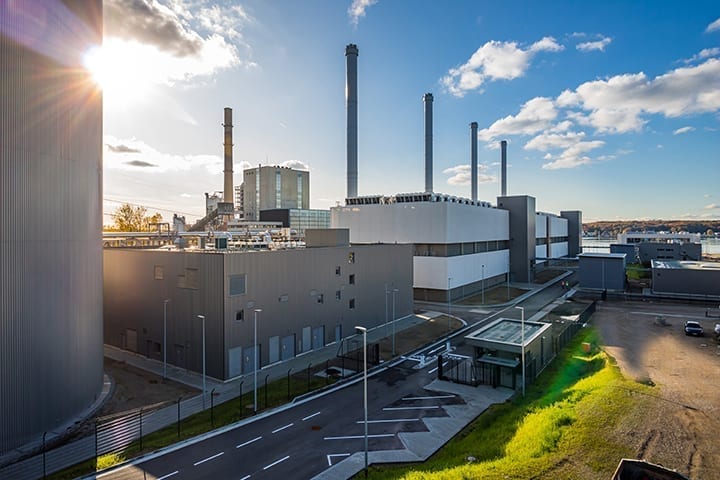Benefits of Reciprocating Engines in Power Generation
Many experts believe power plants constructed with reciprocating engines are the ideal complement to intermittent renewables. Recip plants are extremely flexible. Facilities can be sized for almost any use case; engines are highly reliable, provide quick start and stop capability, and can be run on a variety of liquid and gaseous fuels; units are very efficient (especially when incorporated into combined heat and power schemes) over a wide range of loads; and plants are relatively low cost and can be built quickly with minimal risks of delay.
Everyone in the power industry (and really in the world) is familiar with reciprocating engines. After all, they are what powers most vehicles that people drive or ride in every day. But reciprocating engines are not what comes to mind when most people think about electric power generation. The more typical power plant utilizes turbines to spin generators, driven by either steam or natural gas.
“Often customers have a long-standing turbine bias, and believe that a multi-engine plant will need dramatically more maintenance staff,” Jukka Lehtonen, vice president of Technology & Product Management with Wärtsilä Energy, told POWER, noting that a lack of familiarity with the technology is a hindrance to more widespread adoption. “In reality, operations and maintenance staffing for a recip plant is about the same as needed for a gas turbine plant of similar size.”
Beyond the manpower misconception, there are other things that people get wrong about recip plants. A lot of folks think reciprocating engines are prone to high emissions; after all, who hasn’t seen a diesel truck driving down the road with black smoke billowing out of the exhaust? However, original equipment manufacturers (OEMs) are keenly focused on that issue.
“The biggest concern of our customers nowadays is emissions, and especially finding solutions for reducing CO2 emissions,” said Dr. Tilman Tütken, MAN Energy Solutions’ head of Sales Power Plants, Europe. “Our engines are equipped with the latest emission-reduction equipment that keep emission levels at a minimum. Furthermore, they are also prepared for a CO2-neutral future as they are capable of running on synthetic fuels derived from renewable energy using Power-to-X technology. As an example, dual-fuel and gas engines will also be able to run on carbon-neutral, synthetic natural gas in the future without further technical adaptions, making them a future-proof investment for customers.”
Flexibility Is Key
Real estate agents often say a property’s three most important attributes are location, location, and location. Today, the three most important attributes of a power plant could be flexibility, flexibility, and flexibility. And recip plants have that trait covered.
Lehtonen noted that reciprocating engines offer flexible dispatch. They can be started multiple times per day with no maintenance penalties. Wärtsilä’s engines have a minimum uptime of one minute, minimum downtime of five minutes, and a minimum stable load of 10%. These features make engines ideal for balancing renewables, capitalizing on ancillary service opportunities, and optimizing real-time dispatch requirements.
Reciprocating engines are also fuel flexible (see sidebar “Gas Engines Offer Many Benefits”). They can deal with a very broad spectrum of liquid and gaseous fuels. Natural gas and heavy fuel oil are common, but engines can also be configured to run on different kinds of biofuels and biogases, as well as carbon-neutral synthetic fuels, as previously noted. Furthermore, some decentralized engine-based power plants are utilizing liquefied natural gas (LNG). Tütken noted that many conventional liquid-fueled engines can easily be retrofitted for dual-fuel operation, which offers owners planning flexibility.
|
Gas Engines Offer Many Benefits Carlos Lange, CEO and president of INNIO, whose portfolio includes the Waukesha and Jenbacher gas engine brands, told POWER there are a number of benefits provided by gas engines. He said gas engines complement renewable energy resources by balancing and decoupling energy production and consumption. Furthermore, gas engines can run not only on natural gas, but also on a variety of other gases including biogas, landfill gas, sewage gas, synthetic gases, and hydrogen. Moreover, they allow for decentralized power and heat generation right at the point of use. INNIO reportedly has about 6,000 biogas engines installed globally, converting biogas and biomethane into electricity and heat. By providing customized energy solutions that add electrical efficiency, higher power output, longer lifetimes, lower emissions, and fuel flexibility to a power company’s installed fleet, gas engines help plant operators keep pace with changing market conditions, and meet new industry needs and challenges over the lifetime of the assets. Remote access to equipment can also be extremely beneficial. Lange said up to three-quarters of newly delivered gas engines are connected to INNIO’s myPlant asset performance management (APM) solution, a cloud-based advanced Internet of Things (IoT) platform that allows secure remote engine asset monitoring. Lange noted that power generation is becoming more decentralized, and he said gas engines are at the heart of this global energy transformation. INNIO’s distributed power solutions are said to be an excellent fit for a carbon-neutral, greener and more secure future. Combined heat and power (CHP) facilities can achieve total efficiencies of up to 95%, according to Lange. This pays off for both the operator and the environment. In some cases, the investment in a CHP plant can pay for itself in three to four years, he said. Lange mentioned a plant in Germany as one example. Stadtwerke Kiel replaced a coal-fired power station in January 2020 with one of Europe’s most modern and flexible gas engine-based CHP plants (Figure 1). Twenty Jenbacher J920 FleXtra gas engines were installed, providing a total electrical output of 190 MW and a thermal output of 192 MW. Both power and heat from the plant feed into the electricity grid and district heating network operated by Stadtwerke Kiel, helping to maintain grid stability across Northern Germany.
Across Japan, Waukesha gas engines are providing high-efficiency baseload/continuous power for CHP plants, as well as fast-start emergency backup power, Lange said. The heat and power generated are primarily used for hot water utilization. These Waukesha dual-purpose gensets help meet customer demands for a balance of high efficiency and fast startup, he said. |
Recip plant sizing is also flexible. Facilities can be built to literally any MW size using medium-speed engines of roughly 1 MW to 20 MW each. This makes plants ideal for distributed generation requiring sub-50-MW plant sizing and for larger plants in the hundreds of MW (Figure 2).
 |
|
2. Recip plants come in all sizes. The Quisqueya facility in the Dominican Republic includes 24 Wärtsilä Flexicycle 50DF multi-fuel engines, providing a combined 430 MW of capacity. Courtesy: Wärtsilä |
Jim Williams Jr., NorthWestern Energy’s director of Thermal & Wind Generation, said the flexibility also extends to “right-sizing” power generation capabilities at any given time. For some background, NorthWestern Energy signed a deal with Caterpillar Inc. in June to have the well-known machinery and engine OEM supply an integrated power solution that includes six Cat G20CM34 gas generator sets (Figure 3) for a new 58-MW power plant to be built near Huron, South Dakota.
 |
|
3. NorthWestern Energy is constructing a 58-MW power plant near Huron, South Dakota, that will include six Cat G20CM34 gas generator sets. The engines will replace combustion turbines currently operating at the Huron Generating Station. Courtesy: Caterpillar Inc. |
Williams explained the right-sizing concept, “Let’s say we need an additional 20 MW of power in the system. If the only way to meet this need is a large 50- to 60-MW combustion turbine, we would have to derate the engine, which would be extraordinarily inefficient and more costly for our customers. On the other hand, by having a fleet of 9-MW generator sets, such as what we’re installing in Huron, we can incrementally increase or decrease our power capacity in smaller blocks that allow us to meet the power need as efficiently as possible.”
Efficiency, Reliability, and Resiliency
In addition to being flexible, reciprocating engines are also highly efficient. “Modern simple cycle medium-speed recip plants have net heat rates in the 8,000–8,400 Btu/kWh range (HHV [higher heating value], measured on the high side of step-up transformers). This translates to approximately 10% less fuel consumption per MWh than the most-advanced aeroderivative gas turbine,” Lehtonen said.
Tütken also boasted about the efficiency of reciprocating engines over a wide range of load and operating conditions. “Engine power plants can achieve an efficiency rate of more than 50% in single-cycle,” he said. “As part of a cogeneration power plant, you can even get a system efficiency of as much as 95%.”
Furthermore, engines are less sensitive to altitude, ambient temperature, and humidity variables than other technologies. For example, studies have found that gas turbine efficiency deteriorates by about 1% for every 10-degree increase in temperature above International Organization for Standardization, or ISO, conditions. That can translate into a power output reduction under some conditions of 5% to 10% for gas turbines. Reciprocating engines, meanwhile, retain their rated efficiency and power output over a broader range of ambient conditions.
To compensate for output reductions, gas turbine OEMs use various techniques to cool inlet air and boost turbine output, including evaporative coolers and mechanical chillers. However, inlet air cooling requires additional power consumption, and the effectiveness of cooling systems is highly dependent on ambient humidity. No water consumption is required for reciprocating engines. Recip plants use closed-loop radiator cooling, and water injection is never needed to increase power output.
When it comes to reliability, engines are hard to beat. “Forced outage rates are less than 1% per unit, which means for a multi-unit plant the probability of all engines being down at once for an outage is infinitesimally small (compared to a single-shaft plant). Also, maintenance can be staged to assure maximum online capacity at any point in time,” said Lehtonen.
Williams also noted the benefit provided by a multi-engine plant. “When a single, high-capacity turbine goes offline for maintenance or service, we lose all of the power generation capability at that plant. Alternatively, by operating a fleet of multiple gas generator sets, we have additional units available to pick up the slack if one goes offline,” he said.
The black-start capability that engines offer is another benefit that cannot be overstated. Many plant owners have selected reciprocating engines because of the resiliency this advantage delivers during severe weather or other natural disasters (see sidebar “Benefits of Islanding”).
|
Benefits of Islanding Pacific Gas and Electric’s (PG&E’s) Humboldt Bay Generating Station in Eureka, California, a facility commissioned in 2010 with 10 Wärtsilä 18V50DF engines, completed a reconfiguration in June that will allow portions of Humboldt County to be separated from the larger grid and energized exclusively from the plant when transmission sources that import, export, and stabilize power to nearby areas are impacted. PG&E said “islanding” 20 cities and towns, including Eureka, Arcata, McKinleyville, and Fortuna, as well as some tribal communities, is possible now using the plant. “This represents a significant milestone, not just in Humboldt County where customers will benefit directly, but for all of the customers in our service area who will benefit as we look for innovative solutions to reduce the impact of Public Safety Power Shutoffs [PSPSs],” Andy Vesey, CEO of PG&E’s utility company, said in a statement announcing the project’s completion. PSPSs are one of the measures some California utilities have taken to address wildfire risk during times of high temperatures, extreme dryness, and high winds. In certain situations, companies will cut power to areas to reduce the risk of an equipment failure sparking a wildfire. Victims of wildfires filed billions of dollars in claims against PG&E, forcing the company to file for bankruptcy on Jan. 29, 2019. The company emerged from Chapter 11 on July 1, 2020, and has taken a variety of steps to avoid future trouble. “Our residents and businesses endured hardships during safety shutoffs even when there wasn’t a wildfire threat in Humboldt County,” Humboldt County’s First District Supervisor Rex Bohn said in a statement. “PG&E leadership answered our calls to make sure they did everything they can to reduce impacts next time.” Depending on the situation, as many as 67,000 customers, who might have lost power when areas outside of Humboldt County faced extreme weather conditions, can now remain energized by islanding with the recip plant. PG&E said the size of the energized area is scalable to the scope of the potential PSPS event and other conditions that could be impacting the grid at the time. |
A Solid Choice for Power Generators
Recip plants often have a standardized, modular design that minimizes construction time, making them much faster to build than a combined cycle gas turbine or steam/boiler plant. Typical execution timelines range from a year to 18 months for turnkey projects. Commissioning usually takes from one to two months depending on the plant size.
“As with every new generation plant that we plan to build, we performed an exhaustive assessment of the current and anticipated power need for the area serviced by the Huron Generating Station. We also conducted a survey to evaluate all available technologies and select the mix that best meets our needs,” Williams told POWER, noting that reciprocating engines were the lowest-cost means of meeting NorthWestern Energy’s portfolio resource adequacy requirements.
“In this particular instance, reciprocating engine technology will provide the best solution. It gives us the quick ramp-up, reliability, and right-size energy blocks that we need to cost-effectively cover periodic deficits for our customers. It also provides us with a measure of insurance to address peak load electrical demand in today’s dynamic power market. If we see a spike in power prices, we can rapidly start the precise number of reciprocating-engine generator sets that we need to minimize costs for our customers,” he concluded. ■
—Aaron Larson is POWER’s executive editor.
